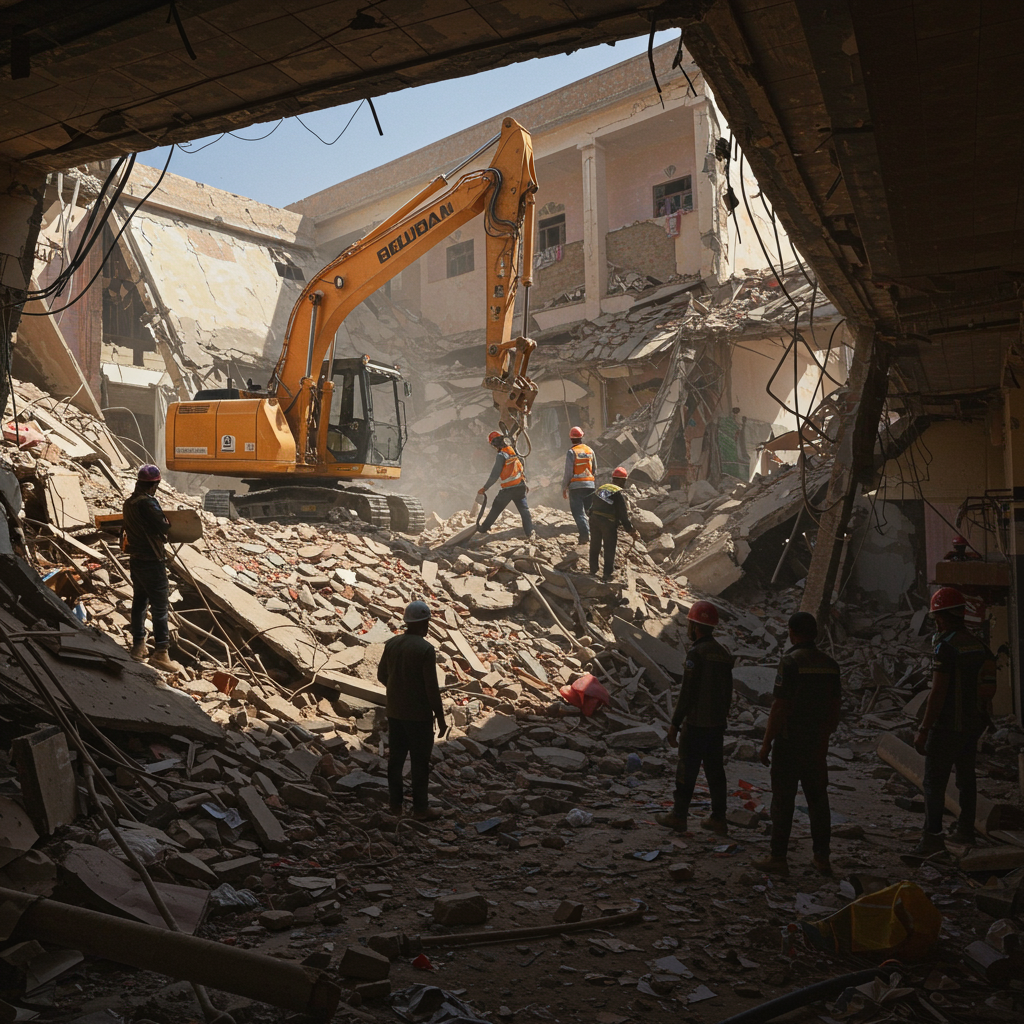The island of Java is gripped by a profound tragedy as rescuers battle time and perilous conditions in Sidoarjo, Indonesia. A multi-storey building at the Al-Khoziny Islamic boarding school dramatically collapsed, trapping dozens of young students beneath a mountain of twisted metal and concrete. This heartbreaking incident, which unfolded during afternoon prayers, has ignited a desperate search for survivors, complicated by a powerful earthquake and widespread concerns about structural safety in Indonesia. The fight to reach children buried alive is an urgent race against the clock, captivating the nation and highlighting critical issues in construction oversight.
Desperate Search: The Sidoarjo School Collapse
Tragedy Strikes During Prayers
On a Monday afternoon, the Al-Khoziny Islamic boarding school in Sidoarjo, East Java, transformed into a scene of unimaginable devastation. As hundreds of mostly teenage boys gathered for their afternoon prayers, the multi-storey structure suddenly gave way. What began as a routine spiritual assembly quickly became a frantic struggle for survival, burying students beneath heavy debris. Girls praying in a separate section of the school fortunately managed to escape the immediate collapse, a small mercy in a sprawling catastrophe. Eyewitnesses, like 13-year-old Muhammad Rijalul Qoib, recalled a growing sound of falling rocks before the terrifying collapse, managing to run but still struck by debris before climbing to safety.
Mounting Casualties and Uncertain Numbers
In the immediate aftermath, initial reports painted a grim picture. While specific figures remained fluid due to the chaotic nature of the disaster, authorities eventually reported that approximately 90 to 91 students, primarily boys aged 12 to 18, were suspected to be buried. The incident left around 100 people injured, many suffering severe head trauma and broken bones, with some even requiring amputations. As rescue operations intensified, officials confirmed seven victims were evacuated, five found alive but two deceased. This tragic count brought the total confirmed fatalities from the Indonesia school collapse to five by Wednesday, a number rescuers feared would rise. Families, in agony, frantically checked names against whiteboards, desperate for any news of their missing loved ones.
Against All Odds: The Perilous Rescue Operation
Innovative Tactics in Unstable Rubble
Indonesia’s National Search and Rescue Agency immediately launched a massive operation, deploying over 300 dedicated personnel to the scene. Rescuers faced immense challenges: an unstable mountain of concrete, steel, and rubble. The fear of further collapse meant heavy machinery was largely avoided, as even a single vibration could trigger another devastating shift. Instead, teams painstakingly employed smaller tools, chipping away at concrete blocks and steel bars with hammers and hand-held power tools. They meticulously crawled through narrow underground culverts, some offering only 60cm of access, to reach potential victims.
Advanced technology became a crucial ally. Thermal-sensing drones and specialized sensors scanned the debris, helping pinpoint potential locations of survivors and the deceased. Signs of life were detected in at least seven distinct areas, offering fleeting but powerful glimmers of hope. Rescuers strategically sent oxygen, water, and food through small cracks and gaps, desperately trying to sustain those trapped below.
The “Golden Period” Nears its End
Mohammad Syafii, head of the National Search and Rescue Agency, underscored the critical nature of the “golden period” – the first 72 hours after a disaster, when survival chances are highest. As this window rapidly closed, the urgency became palpable. On Wednesday, a significant breakthrough occurred when one boy was successfully pulled from the rubble alive, joining others who had been rescued earlier. Despite the grim realities, Syafii expressed cautious optimism, noting that with fluids and vitamins, people could potentially survive longer than the initial 72-hour timeframe, fueling the rescuers’ tireless efforts. The communication abilities of the five initial survivors, as noted by operational director Yudhi Bramantyo, provided vital intelligence for the ongoing search.
Earthquake: A New Layer of Disaster
Debris Compaction and Narrowing Hope
As if the initial collapse wasn’t catastrophic enough, a new and dire complication emerged on Wednesday: a powerful 6.5-magnitude earthquake. While the quake struck the region of Sumenep, approximately 200km (124 miles) from Sidoarjo, its impact on the already fragile collapse site was devastating. The tremors further compacted the debris, drastically narrowing the limited spaces where victims might have been clinging to life. Mohammad Syafii explained the alarming effect: “If the space was initially 50cm (20 inches) high, it caved in to 10cm (four inches), and we fear it impacts the constriction of the victims.” This reduction in space not only made physical access more difficult for rescuers but also increased the immediate danger to those trapped, raising fears of further injuries and reduced survival chances. The earthquake briefly halted rescue work overnight, a stark reminder of the precariousness of the situation.
Anguish and Outcry: Families Await News
Emotional Toll and Calls for Urgency
For the families of the missing, the days turned into an agonizing wait. Distraught parents camped outside the school, their hope battling despair. Abdul Hanan, whose 14-year-old son was missing, articulated the profound emotional toll: “We believe our children might still be alive because they were crying for help.” Dewi Sulistiana, also awaiting news of her 14-year-old son, voiced the desperate frustration, questioning the pace of the search: “Why is it taking so long to find him? Why is the search so slow? I haven’t had any updates, so I just wait.”
The constant cries and shouts heard from beneath the rubble intensified their anguish, fueling desperate pleas for an acceleration of rescue efforts. Family members shared stories of screaming their children’s names into the wreckage, clinging to any sound that might indicate life. The emotional burden on these families is immense, a heartbreaking testament to the human cost of the disaster.
A Systemic Failure: Indonesia’s Building Safety Crisis
Unauthorized Expansions: A Fatal Flaw
The tragedy at the Al-Khoziny Islamic boarding school quickly exposed a pervasive and dangerous issue in Indonesia: lax construction standards and a culture of unauthorized building expansions. Authorities revealed that the collapsed structure, originally a two-storey building, was undergoing an unauthorized expansion to add two additional levels. The school management had not obtained the necessary permits for this construction, which had reportedly been ongoing for nine months. Expert analysis, including from Abdul Muhari of the National Disaster and Mitigation Agency, pointed to a fundamental flaw: the building’s foundation pillars simply could not support the immense weight of the new construction, particularly during the concrete pouring process for the new floors. This fatal decision to expand without proper assessment or permits directly led to the catastrophic Indonesia school collapse.
A Pattern of Tragedies
This incident is not an isolated event but part of a disturbing pattern across Indonesia. The Al-Khoziny school, being the oldest in East Java and holding significant historical and religious standing, makes this particular collapse especially poignant. Earlier in the same month, at least three people were killed and dozens injured when another building, hosting a prayer recital, collapsed in West Java province. Preceding these recent events were tragedies such as seven teenagers killed in a building collapse in Cirebon in 2018 during a musical rehearsal, and 75 people injured the same year when a mezzanine floor collapsed at the Indonesian stock exchange building in Jakarta. These repeated disasters underscore a systemic failure in building safety regulations and enforcement, where structures are often left partially completed for owners to add extra floors later when budgets allow, frequently without adequate safety measures or proper oversight.
Towards Safer Structures: Lessons from the Disaster
Strengthening Regulations and Oversight
The Sidoarjo school collapse serves as a stark reminder of the urgent need for comprehensive reforms in Indonesia’s construction sector. Civil engineering experts, like Mudji Irmawan, have repeatedly advised extreme caution during such structural work, emphasizing the inherent risks. Abdul Muhari of the BNBP has explicitly called for stricter safety regulations and urged both the public and building managers to oversee construction processes more diligently. Implementing and rigorously enforcing these regulations could prevent similar tragedies. This includes mandatory structural integrity assessments before any expansion, transparent permitting processes, and regular inspections by qualified personnel.
Community Vigilance: A Shared Responsibility
Beyond government regulation, there is a role for increased community vigilance. Property owners, school administrators, and local residents must understand the dangers associated with unauthorized construction. Educating the public about safe building practices and the importance of adhering to codes can foster a culture of safety. The emotional pleas of families after the Indonesia school collapse highlight the devastating consequences when these standards are ignored. This tragedy compels a collective re-evaluation of how buildings are planned, constructed, and maintained across the archipelago, ensuring that such preventable disasters are relegated to history.
Frequently Asked Questions
What caused the Al-Khoziny Islamic boarding school collapse in Indonesia?
The primary cause of the Al-Khoziny Islamic boarding school collapse in Sidoarjo, East Java, was the unauthorized addition of two extra floors to an existing two-storey building. School management had not obtained the necessary permits for this expansion, which had been ongoing for about nine months. Experts determined that the original foundation pillars were unable to support the increased weight, leading to a structural failure, possibly during the concrete pouring for the new levels. This highlights a critical issue of lax construction standards and inadequate oversight in Indonesia.
How are rescuers working to save survivors after the school collapse?
Rescuers from Indonesia’s National Search and Rescue Agency are employing a multi-faceted approach, involving over 300 personnel. Due to the unstable nature of the debris, they are largely avoiding heavy machinery, instead using smaller tools to meticulously dig through rubble by hand. They have dug underground tunnels to reach trapped victims and are utilizing thermal-sensing drones and specialized sensors to locate survivors. Water, food, and oxygen are being sent through small cracks, and rescuers are racing against the critical 72-hour “golden period” for survival, despite the added complication of debris compacted by a recent earthquake.
What are the broader implications of the Indonesia school collapse for building safety?
The Al-Khoziny Islamic boarding school collapse underscores widespread concerns about building safety in Indonesia, where unauthorized construction and lax standards are common. It highlights a systemic issue where structures are often expanded without proper permits or structural assessments, leading to catastrophic failures. This incident, following other recent building collapses in the country, reinforces the urgent need for stricter government regulations, more rigorous enforcement of building codes, and increased public awareness regarding safe construction practices to prevent future tragedies and protect lives.
Conclusion: A Call for Lasting Change
The Indonesia school collapse at Al-Khoziny Islamic boarding school is a profound and painful reminder of the human cost when safety standards are neglected. As dedicated rescuers continue their desperate work, fueled by faint hopes of finding more survivors, the nation grapples with the underlying systemic issues that led to this tragedy. The anguish of families, the heroism of rescue teams, and the devastating impact of both structural failure and natural disaster converge in Sidoarjo. This moment must serve as a catalyst for genuine and lasting change, compelling a national commitment to robust building safety regulations and vigilant oversight, ensuring that no more lives are lost to preventable collapses in Indonesia.




